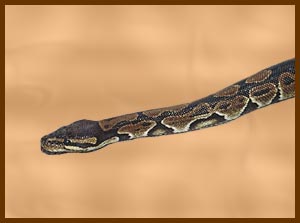|
COLORATION / PATTERN / DESCRIPTION |
Variable
with patterns in tan, brown, red-brown, yellow, and yellow-orange. Robust.
|
| SELECTING |
It
is best to obtain captive born animals whenever possible.
Select an animal that has a well-rounded body as opposed to one with
pronounced
ribs and backbone.
If
one handles the snake, the animal should feel muscular.
Check the snake for signs of illness:
Mouthrot will appear as caseous matter around the gum area.
Respiratory infection may be accompanied by bubbly mucus inside of the
mouth.
Eyes should be clear (except when the snake is shedding or about to
shed).
Broken ribs may appear as collapsed areas along the sides of the snake.
Infections may appear as raised and / or damaged scales.
Check the snake for ticks and mites.
|
| CARE |
NEW SNAKE
It is suggested to have the animal's stool checked for parasites. Parasite
treatment should be as indicated by the veterinarian.
The animal should be handled as little as possible for 2 weeks.
ENCLOSURE
It is highly suggested that one purchase or build an enclosure specifically
designed to house snakes. Ball Pythons are very accomplished escape
artists.
Size: 36" x 12"
Ground Covering: Newspaper, shredded cypress or fir bark, or reptile
carpet.
Temperature: Day = 80 degrees - 85 degrees F. Basking area = 90 degrees
F. Night
= 75 degrees - 80 degrees F. Feeding periods = 85 degrees - 90 degrees
F. If using
bulbs for heat, the bulbs must be situated in such a way as to eliminate
any
direct contact with the snake. Double check air and surface temperatures.
Lighting: No special lighting is required as Ball Pythons are nocturnal.
Hide Box should be provided.
Climbing Branches should be provided.
FEEDING
A healthy Ball Python should have the ability to and may choose to fast
for
several months.
Hatchlings: Should feed on 10-day-old fuzzy mice approx. 2 weeks after
their
first shed.
Ball Pythons can eat mice, and fuzzy rats once or twice a week.
WATER
Water should be provided in a large shallow bowl. The bowl should be
large
enough to allow the snake to soak
prior to shedding.
|
| BREEDING |
It is important to note that there is conflicting information from different
breeders.
Most snake breeders suggest housing the pair separately.
They should only be "introduced" to each other during specific
breeding
time periods. There have been situations, however, when a pair that
has been
housed together for years, has"out of blue" mated and produced
eggs.
It is advantageous to mimic the climatic pattern of the animal's
home range
as well.
Starting on November 1st, shut off all cage heating at night (12 - 14
hours).
The night temperature should be 68 degrees - 74 degrees F. There should
be no
lighting during these 12 - 14 hour night periods. Heating and lighting
should
be normal during the day. No food should be offered during this time.
Starting December 1, the female should be housed with the male once
each
week for a period of 2 days.
February 15th will end the breeding period. Lighting, heating, feeding,
and
housing should be brought back to normal. Gravid (pregnant) females
will often
refuse food.
Egg Laying
Females will start to appear gravid in late December to February. Egg
laying
will usually take place in March or April. Occasionally, egg laying
will occur
as early as February. A clutch should consist of 4 - 10 eggs. By some
accounts,
females will brood their eggs. When brooding their eggs, females will
not
feed.
Most breeders use incubators.
Eggs are half buried in moistened vermiculite (equal parts by weight
of vermiculite
and water) in a covered container. The container is kept in an incubator
at
a temperature range of 88 degrees- 90 degrees F for about 90 days. A
thermometer
should be kept inside of the incubator so that temperature can be carefully
monitored. 2 weeks before the expected hatching date, the temperature
should
be lowered by 1 - 2 degrees F.
Many breeders construct their own incubators.
Aquarium with a shallow water level and a submersible heater. The container
of eggs is kept above the water by placing it on bricks or something
similar.
A Styrofoam lid is used to keep the heat in the incubator.
Hatching
Hatchlings will many times break open part of the egg, poke their heads
out,
but remain in the egg for about 24 hours. During this time, hatchlings
should
not be handled. After this hatching period, the hatchlings should be
placed
into normal Ball Python enclosures.
|
